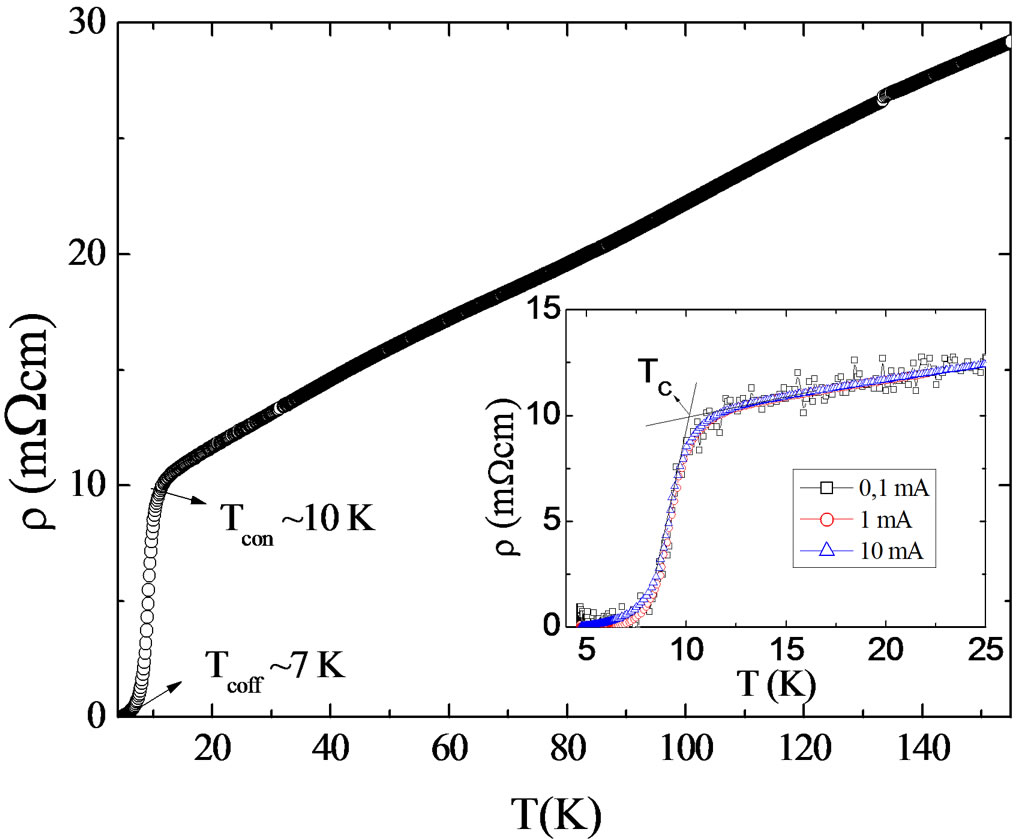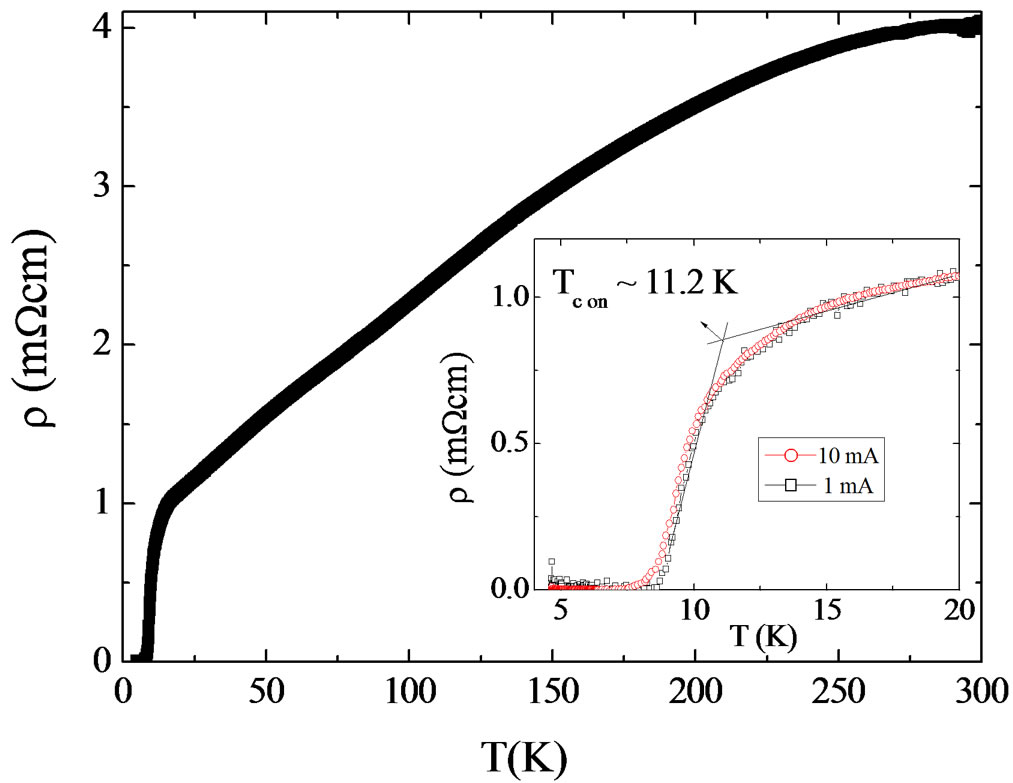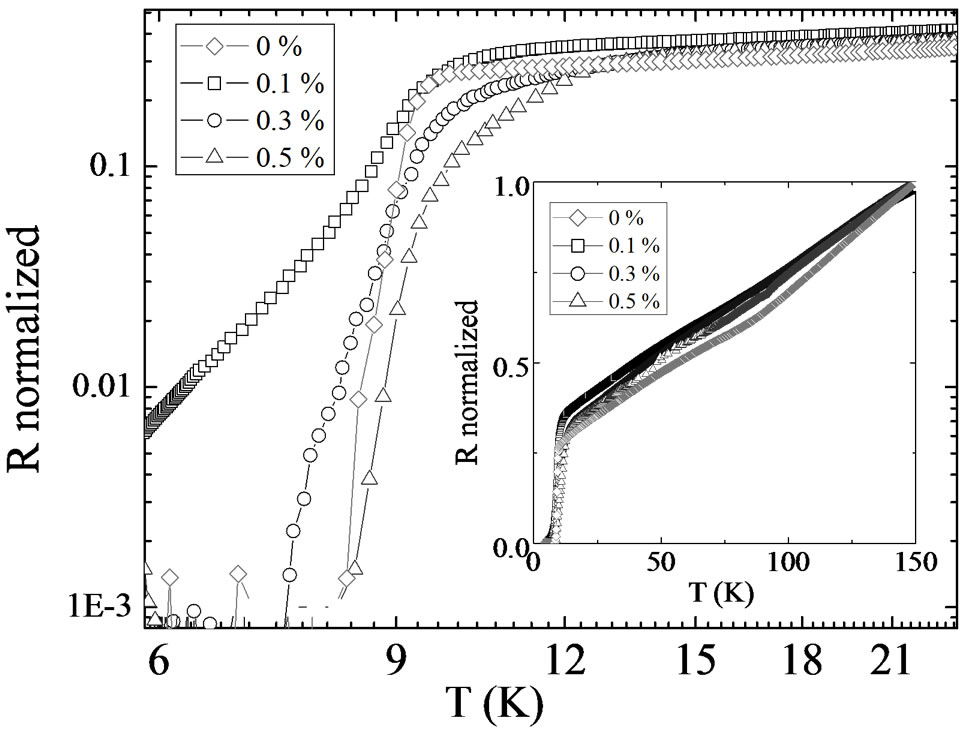Materials Sciences and Applications
Vol.3 No.9(2012), Article ID:22903,4 pages DOI:10.4236/msa.2012.39090
Influence of the Fluoride Atoms Doping on the FeSe Superconductor
![]()
1Departamento de Engenharia de Materiais, Escola de Engenharia de Lorena—USP, Lorena, Brazil; 2Universidade Federal de Itajubá, Campus de Itabira, Itabira, Brazil.
Email: ausdinirbortolozo@unifei.edu.br
Received March 29th, 2012; revised May 2nd, 2012; accepted July 3rd, 2012
Keywords: Superconductivity; Pnictides; Interstitial
ABSTRACT
It is reported the influence of the interstitial atoms doping on the FeSe superconductor. Polycrystalline samples with FeSeFx and FeSeBx nominal compositions were prepared by solid state reaction. An enhancement of the superconducting transition temperature was observed in the temperature dependence of the electrical resistivity curve to the FeSeF0.015 sample. R(T) data display superconducting behavior close to 12 K. The Tc increased with F doping by up to 50%. In contrast, boron doping no change the superconducting properties of the FeSe compound. As the FeSe1–xTex system the fluoride doping introduce a negative chemical pressure in the FeSe superconductor. This fact suggests that fluoride doping have changed the electronic properties of the FeSe phase.
1. Introduction
Since the surprisingly discovery of superconductivity in high temperature of 55 K to the fluorine-doped rare-earth iron oxyarsenides, REFeAs1–xFx, many research has been made on new superconducting materials [1-4]. The new materials class has Fe and share a common structural feature. In 2008, Hsu et al. [5] reported the superconductivity at 8 K in PbO-prototype FeSe compound knows as “11” family. FeSe system is one of the most attracting systems, because it has the simplest crystal structure among the ironbased superconductors [5,6]. McQueen has been shown that superconductivity in Fe1+δSe is destroyed by very small changes in stoichiometric [7]. They also showed that nonsuperconducting Fe1+δSe is not magnetically ordered down to 5 K and it is destroyed by very small changes in stoichiometry. Then, immediate instability against an ordered magnetic state should not be considered as intrinsic characteristic [7].
While a superconducting transition temperature Tc of FeSe at ambient pressure is ~8 K, the Tc has been raised to 27 K with the application of pressure [8-10]. Compared with the layered FeAs systems, FeSe has not only the same planar sublattices but also displays structure and magnetic instability [11-14]. Within the family of “11” binary iron chalcogenides the superconducting state exists over a wide range of Te-doping in the Fe (Se, Te) solid solution with maximum Tc of 15 K [15-22]. These substitutions generate chemical pressures, because S, Se and Te have the same valence and the different ionic radius. Considering the huge positive pressure effect on Tc, compressing the lattice seems to be effective to enhance Tc. However the increase of Tc in FeSe1–xSx, which is chemically pressured FeSe, is only 2 K. On the other hand, the increase of Tc in FeSe1–xTex, which is applied a negative chemical pressure, is the lager value of 5 K. In fact, the physical pressure and chemical pressure effects are not equivalent in FeSe system [15-22]. Here we report the influence of interstitial doping on the FeSe superconductor. We found that the FeSe + 0.5% FeF3 shows superconducting transition like Fe (SeTe) solid solution. On the other hand, the low content boron atoms doping do not change the electric and magnetic properties of FeSe superconductor.
2. Experimental Procedure
FeSeFx were prepared using mixtures of appropriate amount of high purity Fe, Se, and x% FeF3 (x = 0.1, 0.3, and 0.5) powders. The mixtures were compacted in square shape of 10 × 10 mm2 and 2 mm thick, sealed in a quartz ampoule, and placed inside a box furnace model Lindberg/ Blue M furnace at 1000˚C for 10 hours, and cooled at 400˚C and, then kept for 3 days. After this heat treatment, the samples were ground and homogenized in agate mortar, compacted again in the same dimensions mentioned before, and sintered at 400˚C for 3 days. After this additional heat treatment, the samples were submitted to a rapid quenching in water in order to trap the tetragonal phase. All samples were characterized by X-ray powder diffraction in a Shimadzu diffractometer (model XRD 6000) using Ni filter CuKα radiation. The simulation of the structure and refinement of the lattice parameters were carried out by using both the Powder Cell software and the Rietveld method. The simulation of the crystal structure was based on the literature data and the results were compared with the experimental diffractograms. The electrical resistance as a function of temperature, R(T), were performed by conventional four-point probe method in the temperature interval between 2.0 and 300 K. In order to remove the thermal power effects arising in the silver-soldered samples terminal, the measurements were done by applying an alternating polarity of the dc current and taking the average voltage between the two measurements.
3. Results and Discussions
X-ray powder diffraction data at room temperature for the FeSe + x% FeF3 (x = 0.1; 0.3 and 0.5) samples are displayed in Figure1. All peaks can be indexed based on tetragonal structure space group P4/nmm, with lattice parameters a = 3.36 Å and c = 5.52 Å. These results reveal that F atoms are been solubilized within the crystalline structure of the space group P4/nmm.
In order to determine what site fluoride doping is occupied the refinement of X-ray data was made. The initial analysis suggests that F atoms could occupy the “4d” Wyckoff position. While the increase F content form nominally 0.3% to 0.5% leads to relatively small chances in the lattice parameters. The anisotropic expansion of the crystalline structure can be observed on the (200) and (003) reflection. It is possible to observed in the (003) reflection that there is not significantly expansion/contraction of the lattice parameter. On the other hand the (200) reflection the small change could be related.

Figure 1. X-ray diffraction for the FeSe + x% FeF3 showing that the fluoride does not collapse the PbO prototype structure.
In order to study the transport properties of the FeSe + x% FeF3 samples, electrical resistance measurements as a function of temperature have been performed. R(T) curve for the FeSe + 0.1% FeF3 reveals a typical metallic behavior between 15 and 150 K (Figure 2).
The superconducting transition at 10 K with transition broadening of 3 K can be observed in the measurement. This fact shows the fluoride doping does not destroy the superconductivity of the FeSe superconductor. On the other hand, the fluoride doping increases the superconducting temperature. In the inset of the Figure 2 is displayed the measurement between 4.0 K and 25.0 K with different electrical currents.
In the Figure 3 the R(T) curve for the FeSe + 0.3% FeF3 reveals like metallic behavior between 15 and 300 K. On the other hand, the superconducting transition is close to 11.2 K. This fact suggests the fluoride is changing the transport properties of the FeSe superconductor.

Figure 2. Electrical resistance as a function of temperature from 4 to 150 K to the FeSe + 0.1% FeF3 shows the superconducting transition at 10 K. The normal state is an electronphonon scattering.

Figure 3. Electrical resistivity as a function of temperature for the FeSe + 0.3% FeF3 sample. Inset displays the superconducting transition starting at ~11.2 K.
In Figure 4 is shown the R(T) for the FeSe + 0.5% FeF3. The FeSe + 0.5% FeF3 compound superconducts at 13 K (onset temperature). This transition temperature is compared to FeSe0.5Te0.5. The transition broadening is due to impurity in the FeSe + 0.5% FeF3 as is possible to observed in the X-ray diffraction data.
Figure 5 show the normalized electrical resistance as a function of temperature to the FeSeFx. The R(T) data is clear the F doping is changed the electrical behavior of the FeSe superconductor.
The low content boron atoms doping do not collapse the crystalline structure nor change the electrical and magnetic properties of the FeSe superconductor.
4. Conclusion
This work has investigated the effect of fluoride doping in the FeSe superconductor, which exhibits the simplest crystal structure among the iron-based superconductors.

Figure 4. Electrical resistivity as a function of temperature for the FeSe + 0.5% FeF3 sample. Inset displays a superconducting transition starting at ~13 K.

Figure 5. Electrical resistance normalized as a function of temperature to the FeSeFx compounds. The FeSe + 0.5% FeF3 compound superconducts at 13 K (onset temperature). This transition temperature is compared to FeSe0.5Te0.5.
The results show is possible to dope the FeSe superconductor with the interstitial atoms. The boron doping not changes the superconducting properties of the FeSe. On the other hand the fluoride doping applied a negative chemical pressure in the FeSe superconductor which increases the Tc like in the FeSe1–xTex system.
5. Acknowledgements
We are grateful for the helpful discussion with Prof. Antonio Jefferson S Machado. This work is based upon supported by FAPESP (Grants n 2009/00610-8) and by FAPEMIG (Grants n PRI-00049-12).
REFERENCES
- Y. Kamihara, T. Watanabe, M. Hirano and H. Hosono, “Iron-Based Layered Superconductor La[O1−xFx]FeAs (x = 0.05 − 0.12) with Tc = 26 K,” Journal of the American Chemical Society, Vol. 130, No. 11, 2008, pp. 3296- 3297.doi:10.1021/ja800073m
- X. H. Chen, T. Wu, G. Wu, R. H. Liu, H. Chen and D. F. Fang, “Superconductivity at 43 K in SmFeAsO1−xFx,” Nature, Vol. 453, No. 5, 2008, pp. 761-762. doi:10.1038/nature07045
- R. H. Liu, G. Wu, T. Wu, D. F. Fang, H. Chen, S. Y. Li, K. Liu, Y. L. Xie, X. F. Wang, R. L. Yang, L. Ding, C. He, D. L. Feng and X. H. Chen, “Anomalous Transport Properties and Phase Diagram of the FeAs-Based SmFeAsO1−xFx Superconductors,” Physical Review Letters, Vol. 101, No. 8, 2008, Article ID: 087001. doi:10.1103/PhysRevLett.101.087001
- Y. Takabayashi, M. T. McDonald, D. Papanikolaou, S. Margadonna, G. Wu, R. H. Liu, X. H. Chen and K. Prassides, “Doping Dependence of the Pressure Response of Tc in the SmO1−xFxFeAs Superconductors,” Journal of the American Chemical Society, Vol. 130, No. 9, 2008, pp. 9242-9243. doi:10.1021/ja8036838
- F. C. Hsu, J. Y. Luo, K. W. Yeh, T. K. Chen, T. W. Huang, P. M. Wu, Y. C. Lee, Y. L. Huang, Y. Y. Chu, D. C. Yan and M. K. Wu, “Superconductivity in the PbOType Structure Alpha-FeSe,” Proceedings of the National Academy of Sciences of the United States of America, Vol. 105, No. 38, 2008, pp. 14262-14264. doi:10.1073/pnas.0807325105
- C. C. Chang, C. H. Wang, M. H. Wen, Y. R. Wu, Y. T. Hsieh and M. K. Wu, “Superconductivity in PbO-Type Tetragonal FeSe Nanoparticles,” Solid State Communications, Vol. 152, No. 8, 2012, pp. 649-652. doi:10.1016/j.ssc.2012.01.030
- T. M. McQueen, Q. Huang, V. Ksenofontov, C. Felser, Q. Xu, H. Zandbergen, Y. S. Hor, J. Allred, A. J. Williams, D. Qu, J. Checkelsky, N. P. Ong and R. J. Cava, “Extreme Sensitivity of Superconductivity to Stoichiometry in Fe1+δSe,” Physical Review B, Vol. 1, No. 79, 2009, Article ID: 014522. doi:10.1103/PhysRevB.79.014522
- Y. Mizuguchi, F. Tomioka, S. Tsuda, T. Yamaguchi and Y. Takano, “Superconductivity at 27 K in Tetragonal FeSe under High Pressure,” Applied Physics Letters, Vol. 93, No. 15, 2008, Article ID: 152505. doi:10.1063/1.3000616
- T. Imai, K. Ahilan, F. L. Ning, T. M. McQueen and R. J. Cava, “Why Does Undoped FeSe Become a High-Tc Superconductor under Pressure?” Physical Review Letters, Vol. 102, No. 17, 2009, Article ID: 177005. doi:10.1103/PhysRevLett.102.177005
- J N. Millican, D. Phelan, E. L. Thomas, J. B. Leão and E. Carpenter, “Pressure-Induced Effects on the Structure of the FeSe Superconductor,” Solid State Communications, Vol. 149, No. 17-18, 2009, pp. 707-710. doi:10.1016/j.ssc.2009.02.011
- G. Rahman, I. G. Kim and A. J Freeman, “Ab Initio Prediction of Pressure-Induced Structural Phase Transition of Superconducting FeSe,” Journal of Physics: Condensed Matter, Vol. 24, No. 9, 2012, Article ID: 095502. doi:10.1088/0953-8984/24/9/095502
- M. H. Fang, H. M Pham, B. Qian, T. J. Liu, E. K. Vehstedt, Y. Liu, L. Spinu and A. Q. Mao, “Superconductivity Close to Magnetic Instability in Fe(Se1−xTex)0.82,” Physical Review B, Vol. 78, No. 22, 2008, Article ID: 224503. doi:10.1103/PhysRevB.78.224503
- H. Kotegawa, S. Masaki, Y. Awai, H. Tou, Y. Mizuguchi and Y. Takano, “Evidence for Unconventional Superconductivity in Arsenic-Free Iron-Based Superconductor FeSe: A 77Se-NMR Study,” Journal of the Physical Society of Japan, Vol. 77, 2008, Article ID: 113703. doi:10.1143/JPSJ.77.113703
- G. E. Grechnev, A. S. Panfilov, A. V. Fedorchenko, V. A. Desnenko, S. L. Gnatchenko, V. Tsurkan, J. Deisenhofer, A. Loidl, D. A. Chareev, O. S. Volkova and A. N. Vasiliev, “Magnetic Properties of Novel FeSe(Te) Superconductors,” Journal of Magnetism and Magnetic Materials, Vol. 324, No. 21, 2012, pp. 3460-3463.
- K. W. Yeh, T. T. W. Huang, Y. L. Huang, T. K. Chen, F. C. Hsu, P. M. Wu, Y. C. Lee, Y.Y. Chu, C. L. Chen, J. Y. Luo, D. C. Yan and M. K. Wu, “Tellurium Substitution Effect on Superconductivity of the α-Phase Iron Selenide,” Europhysics Letters, Vol. 84, No. 3, 2008, Article ID: 37002. doi:10.1209/0295-5075/84/37002
- B. C. Sales, A. S. Sefat, M. A. McGuire, R. Y. Jin and D. Mandrus, “Bulk Superconductivity at 14 K in Single Crystals of Fe1+yTexSe1−x,” Physical Review B, Vol. 79, No. 9, 2009, Article ID: 094521. doi:10.1103/PhysRevB.79.094521
- T. L. Xia, D. Hou, S. C. Zhao, A. M. Zhang, G. F. Chen, J. L. Luo, N. L. Wang, J. H. Wei, Z.-Y. Lu and Q. M. Zhang, “Raman Phonons of α-FeTe and Fe1.03Se0.3Te0.7 Single Crystals,” Physical Review B, Vol. 79, No. 14, 2009, Article ID: 140510. doi:10.1103/PhysRevB.79.140510
- K. W. Yeh, H. C. Hsu, T. W. Huang, P. M. Wu, Y. L. Huang, T. K. Chen, J. Y. Luo and M. K. Wu, “Se and Te Doping Study of the FeSe Superconductors,” Journal of the Physical Society of Japan, Vol. 77, Suppl. C, 2008, pp. 19-22.
- Y. Mizuguchi, F. Tomioka, S. Tsuda, T. Yamaguchi and Y. Takano, “Substitution Effects on FeSe Superconductor,” Journal of the Physical Society of Japan, Vol. 78, No. 7, 2009, Article ID: 074712. doi:10.1143/JPSJ.78.074712
- S. Li, C. de la Cruz, Q. Huang, Y. Chen, J. W. Lynn, J. Hu, Y. L. Huang, F. C. Hsu, K. W. Yeh, M. K. Wu and P. Dai, “First-Order Magnetic and Structural Phase Transitions in Fe1+ySexTe1−x,” Physical Review B, Vol. 79, No. 5, 2009, Article ID: 054503. doi:10.1103/PhysRevB.79.054503
- K. W. Yeh, C. T. Ke, T. W. Huang, T. K. Chen, Y. L. Huang, P. M. Wu and M. K. Wu, “Superconducting FeSe1−xTex Single Crystals Grown by Optical ZoneMelting Technique,” Crystal Growth & Design, Vol. 9, No. 11, 2009, pp. 4847-4851. doi:10.1021/cg900675e
- R. Viennois, E. Giannini, D. van der Marel and R. Černý, “Effect of Fe Excess on Structural, Magnetic and Superconducting Properties of Single-Crystalline Fe1+xTe1−ySey,” Journal of Solid State Chemistry, Vol. 183, No. 4, 2010, pp. 769-775. doi:10.1016/j.jssc.2010.01.024

